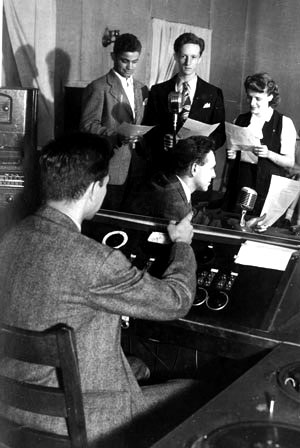
|
February 15, 2007 |
Events and Exhibit to Celebrate 70 Years of College Radio at Brown
From the dorm-room experiment that started it all, to the 1960s FM revolution, to the students behind the stations today – Brown is celebrating 70 years of college radio. The exhibit From Gaspipes to Websites: Radio at Brown 1936-2006 will be on display at the John Hay Library Feb. 21 through March 9, 2007. An opening reception featuring the launch of an audio documentary is planned for Sunday, Feb. 25, 2007, along with a panel discussion titled “The Importance of College Radio.” All events are free and open to the public. | |||
|
Brown University Home |
PROVIDENCE, R.I. [Brown University] — In celebration of 70 years of college radio, Brown University presents the exhibit From Gaspipes to Websites: Radio at Brown 1936-2006, on display at the John Hay Library from Wednesday, Feb. 21 through Friday, March 9, 2007. An opening reception will be held on Sunday, Feb. 25, 2007, from 2 until 5 p.m., featuring the launch of an audio documentary chronicling the history of radio at Brown. Following the reception, WBRU and BSR alumni and current students will take part in a panel discussion titled “The Importance of College Radio” at 7 p.m. in Smith-Buonanno Hall, Room 106. All events are free and open to the public.  Brown University radio is on the air The exhibit and audio documentary are the products of a group independent study course undertaken by student staffers at WBRU and BSR, under the direction of Susan Smulyan. Students worked in the Brown archives at the John Hay Library under the supervision of Gerald Gaidmore, University archivist, and in uncatalogued papers at both stations to compile a history of Brown radio. Amanda Murray, a graduate student in public humanities, serves as curator of the exhibit, which is sponsored by WBRU 95.5, BSR 88.1, Brown University’s Department of American Civilization and the John Nicholas Brown Center. “The exhibit is not just a historical timeline, it’s about the students behind the stations, then and now,” said Smulyan, associate professor of American civilization. ”The exhibit weaves together the students’ motivations for working in radio, the topics they chose to research, and their ideas about the future of radio at Brown – in terms of collaborations, challenges, and changing technologies.” Using documents and photographs from the University archives, audio clips, studio memorabilia, and historic radios from private collector and Brown Graduate School alumnus Ned Connors, the exhibit traces the founding of The Brown Network in 1936, the growing involvement of Pembroke women during and after World War II, the transition from AM to FM in the 1960s, the impact of WBRU’s award-winning news coverage, and the rebirth of BSR in the 1990s. Materials from the exhibit, student essays, and the documents themselves will soon be available on a We site developed with the Center for Digital Initiatives in the Brown libraries. The sixty-minute audio documentary, also titled From Gaspipes to Websites, includes music, archival tape and stories from listeners, DJs, reporters and employees. “It transports the listener on the journey from the dorm-room broadcasts of freshman George Abraham in 1936 to the modern-day stations of WBRU and BSR, which now reach hundreds of thousands of listeners,” explained Smulyan. The documentary was produced by students Rita Cidre, Lindsey Gaydos, and Jason Sigal and is being sponsored by the Cogut Center for the Humanities, the Creative Arts Council, and the Rhode Island Council for the Humanities. Brown alumnus and public radio producer Paul McCarthy served as executive producer. A limited number of complimentary copies of the documentary will be available at the exhibit. It will also be available online in the iTunes stores or at http://bsrserv.bsrlive.com/alumni. Following the reception and documentary launch, WBRU and BSR alumni and current students will present a panel discussion, “The Importance of College Radio,” at 7 p.m. in Brown’s Smith-Buonanno Hall, Room 106. Panelists Peter Tannewald, Don Berns, Dan Oppenheim, Rita Cidre, and Jason Sigal will consider such questions as how participation in college radio affects students’ lives and careers; the way college radio changes American broadcasting; and the unique place of Brown radio in the history of radio and the history of college broadcasting. The event is in the second of a series of panel discussions on radio sponsored by Brown’s Department of American Civilization and the John Nicholas Brown Center. Brown University’s John Hay Library, located at 20 Prospect St., is open 9 a.m. to 5 p.m. Monday through Friday. Editors: Brown University has a fiber link television studio available for domestic and international live and taped interviews, and maintains an ISDN line for radio interviews. For more information, call (401) 863-2476. ###### | |||